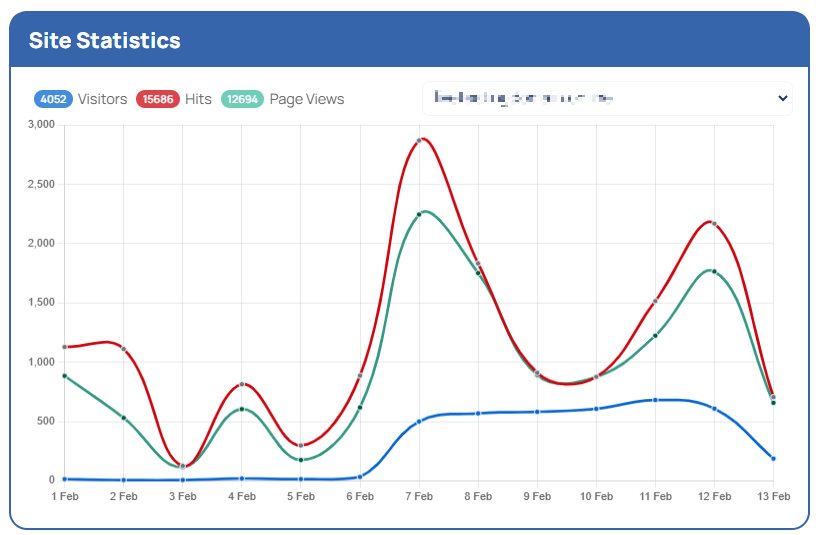Understanding website statistics is essential for assessing traffic and user engagement. The key metrics employed to evaluate website performance encompass Hits, Page Views, Visits, and Unique Visits. Each of these terms carries a specific definition and offers important insights into user interactions with the website you host.
By understanding these metrics, you can make informed decisions regarding content strategy, marketing initiatives, and improvements to your user experience. For deeper analysis and insights into your site’s performance, it is advisable to use analytics tools that offer extensive reporting capabilities customized to your requirements.
TABLE OF CONTENTS
Definitions of Website Statistics

A website dashboard shows a snapshot of site statistics, including visitor count, hits, and page views, once users are logged in.
Page Views
A Page View measures the total number of individual pages accessed by all visitors to your site. This metric accounts for each instance a page is loaded, irrespective of whether the visitor has previously viewed that page or not. Therefore, returning visitors add to the page view count each time they access a page.
Visit
A Visit is recorded when a user arrives at your homepage or any other page on your site. This metric includes all interactions during a single session, which may involve multiple page views by the same visitor. Visits offer valuable insights into overall traffic trends and user engagement over time.
Unique Visit
Unique Visits indicates the number of new visitors who access your website for the first time within a designated timeframe. This metric excludes returning visitors, enabling you to assess how many distinct individuals interact with your site.
Additional Information
What Are Website Statistics?
Website statistics refer to data that detail the traffic and behavior of users visiting your site. These insights are essential for understanding user interaction, allowing you to enhance your site performance, design, and content.
Here are some of the most common website stats:
- Pageviews: The total count of pages viewed on a website.
- Unique Visitors: The number of distinct users visiting a website.
- Bounce Rate: The percentage of users who exit a website after viewing just one page.
- Average Session Duration: The average amount of time users spend on a website.
- Traffic Sources: The various origins of traffic to a website, including search engines, social media, and referrals.
- Conversion Rate: The percentage of users who perform a desired action, like making a purchase or completing a form.
Various tools, including Google Analytics, can collect website statistics. These tools monitor user behavior and engagement and generate reports on site traffic.
Website statistics can be used to:
- Identify Popular Content: Website owners can identify their most popular content with visitors by analysing page views and other metrics.
- Understand User Behavior: Website statistics can provide insights into how users navigate a website, which pages they visit, and how long they stay on each page.
- Improve Site Design: Website statistics can be used to identify areas of a website that are confusing or difficult to use.
- Marketing Analytics: Website statistics can be used to track the traffic generated by marketing campaigns and measure their impact on website conversions.
Significance of Monitoring Website Analytics
- Performance Evaluation: Analyzing these metrics enables webmasters to gauge the effectiveness of their website and recognize patterns in user interactions.
- Content Enhancement: By examining page views and unique visits, one can identify which content appeals most to the audience and make necessary adjustments for improvement.
- Marketing Assessment: Monitoring visits and unique visits offer valuable insights into the success of marketing initiatives, assisting in the refinement of future strategies.
Limitations of Metrics
- Session Duration: The metrics of visits and unique visits do not reflect the duration of user engagement on the site or the pathways they take while navigating. Both are essential for a comprehensive understanding of user interaction.




















